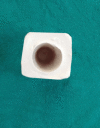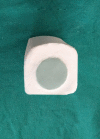Simple and novel technique for fabrication of prosthetic vaginal dilators
- PMID: 31005874
- PMCID: PMC6506128
- DOI: 10.1136/bcr-2019-229524
Simple and novel technique for fabrication of prosthetic vaginal dilators
Abstract
Vaginal agenesis is one of the major congenital anomalies affecting women. Postoperative prosthetic vaginal dilators are indicated in patients treated surgically for vaginal agenesis. Although different dental materials such as acrylics and silicone-coated materials are used, addition silicones alone have never been used for the fabrication of prosthetic vaginal dilators. Addition silicone materials have advantages, such as high elastic recovery, high tear and tensile strengths, which aid in the definitive use of vaginal dilators. Vaginal dilators fabricated using addition silicone materials act as an efficient prosthesis in terms of function and ease of use in surgically treated vaginal agenesis patients.
Keywords: dentistry and oral medicine; obstetrics and gynaecology; obstetrics, gynaecology and fertility; reproductive medicine.
© BMJ Publishing Group Limited 2019. No commercial re-use. See rights and permissions. Published by BMJ.
Conflict of interest statement
Competing interests: None declared.
Figures
References
-
- Kannan RB, Nayak A, Varadhan L, et al. . Mayer-Rokitansky-Kuster-Hauser syndrome and pituitary adenoma: a co-incidence? Endocrine Abstracts 2014;34:143 10.1530/endoabs.34.P143 - DOI
-
- Frank RT. The formation of an artificial vagina without operation. Am J Obstet Gynecol 1938;35:1053–5. 10.1016/S0002-9378(38)90400-4 - DOI
-
- Sangeetha K, Rani GU, Syamala O, et al. . Vaginal reconstruction in müllerian agenesis with user-friendly indigenous prosthetic vaginal dilators. The Journal of South Asian Federation of Menopause Societies 2014;2:75–8. 10.5005/jp-journals-10032-1046 - DOI
Publication types
MeSH terms
Substances
Supplementary concepts
LinkOut - more resources
Full Text Sources
Medical




